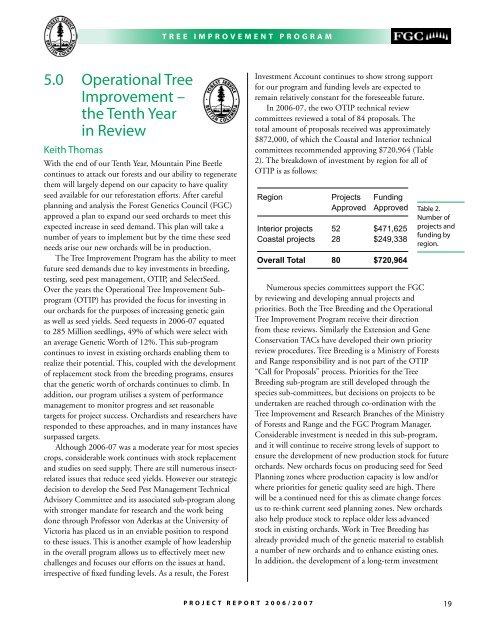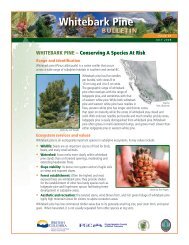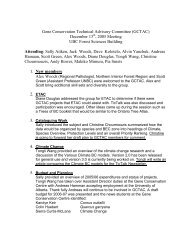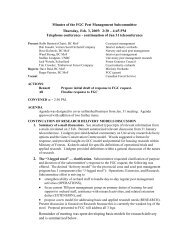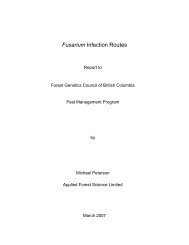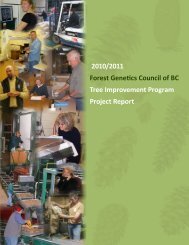Tree Improvement Program Project Report 2006 / 2007
Tree Improvement Program Project Report 2006 / 2007
Tree Improvement Program Project Report 2006 / 2007
You also want an ePaper? Increase the reach of your titles
YUMPU automatically turns print PDFs into web optimized ePapers that Google loves.
.0 Operat onal <strong>Tree</strong><br />
<strong>Improvement</strong> –<br />
the Tenth Year<br />
n Rev ew<br />
Ke th Thomas<br />
With the end of our Tenth Year, Mountain Pine Beetle<br />
continues to attack our forests and our ability to regenerate<br />
them will largely depend on our capacity to have quality<br />
seed available for our reforestation efforts. After careful<br />
planning and analysis the Forest Genetics Council (FGC)<br />
approved a plan to expand our seed orchards to meet this<br />
expected increase in seed demand. This plan will take a<br />
number of years to implement but by the time these seed<br />
needs arise our new orchards will be in production.<br />
The <strong>Tree</strong> <strong>Improvement</strong> <strong>Program</strong> has the ability to meet<br />
future seed demands due to key investments in breeding,<br />
testing, seed pest management, OTIP, and SelectSeed.<br />
Over the years the Operational <strong>Tree</strong> <strong>Improvement</strong> Subprogram<br />
(OTIP) has provided the focus for investing in<br />
our orchards for the purposes of increasing genetic gain<br />
as well as seed yields. Seed requests in <strong>2006</strong>-07 equated<br />
to 285 Million seedlings, 49% of which were select with<br />
an average Genetic Worth of 12%. This sub-program<br />
continues to invest in existing orchards enabling them to<br />
realize their potential. This, coupled with the development<br />
of replacement stock from the breeding programs, ensures<br />
that the genetic worth of orchards continues to climb. In<br />
addition, our program utilises a system of performance<br />
management to monitor progress and set reasonable<br />
targets for project success. Orchardists and researchers have<br />
responded to these approaches, and in many instances have<br />
surpassed targets.<br />
Although <strong>2006</strong>-07 was a moderate year for most species<br />
crops, considerable work continues with stock replacement<br />
and studies on seed supply. There are still numerous insectrelated<br />
issues that reduce seed yields. However our strategic<br />
decision to develop the Seed Pest Management Technical<br />
Advisory Committee and its associated sub-program along<br />
with stronger mandate for research and the work being<br />
done through Professor von Aderkas at the University of<br />
Victoria has placed us in an enviable position to respond<br />
to these issues. This is another example of how leadership<br />
in the overall program allows us to effectively meet new<br />
challenges and focuses our efforts on the issues at hand,<br />
irrespective of fixed funding levels. As a result, the Forest<br />
T R E E I M P R O V E M E N T P R O G R A M<br />
P R O J E C T R E P O R T 2 0 0 6 / 2 0 0 7<br />
Investment Account continues to show strong support<br />
for our program and funding levels are expected to<br />
remain relatively constant for the foreseeable future.<br />
In <strong>2006</strong>-07, the two OTIP technical review<br />
committees reviewed a total of 84 proposals. The<br />
total amount of proposals received was approximately<br />
$872,000, of which the Coastal and Interior technical<br />
committees recommended approving $720,964 (Table<br />
2). The breakdown of investment by region for all of<br />
OTIP is as follows:<br />
Region <strong>Project</strong>s Funding<br />
Approved Approved<br />
Interior projects 52 $471,625<br />
Coastal projects 28 $249,338<br />
Overall Total 80 $720,964<br />
Table 2.<br />
Number of<br />
projects and<br />
fund ng by<br />
reg on.<br />
Numerous species committees support the FGC<br />
by reviewing and developing annual projects and<br />
priorities. Both the <strong>Tree</strong> Breeding and the Operational<br />
<strong>Tree</strong> <strong>Improvement</strong> <strong>Program</strong> receive their direction<br />
from these reviews. Similarly the Extension and Gene<br />
Conservation TACs have developed their own priority<br />
review procedures. <strong>Tree</strong> Breeding is a Ministry of Forests<br />
and Range responsibility and is not part of the OTIP<br />
“Call for Proposals” process. Priorities for the <strong>Tree</strong><br />
Breeding sub-program are still developed through the<br />
species sub-committees, but decisions on projects to be<br />
undertaken are reached through co-ordination with the<br />
<strong>Tree</strong> <strong>Improvement</strong> and Research Branches of the Ministry<br />
of Forests and Range and the FGC <strong>Program</strong> Manager.<br />
Considerable investment is needed in this sub-program,<br />
and it will continue to receive strong levels of support to<br />
ensure the development of new production stock for future<br />
orchards. New orchards focus on producing seed for Seed<br />
Planning zones where production capacity is low and/or<br />
where priorities for genetic quality seed are high. There<br />
will be a continued need for this as climate change forces<br />
us to re-think current seed planning zones. New orchards<br />
also help produce stock to replace older less advanced<br />
stock in existing orchards. Work in <strong>Tree</strong> Breeding has<br />
already provided much of the genetic material to establish<br />
a number of new orchards and to enhance existing ones.<br />
In addition, the development of a long-term investment<br />
19


